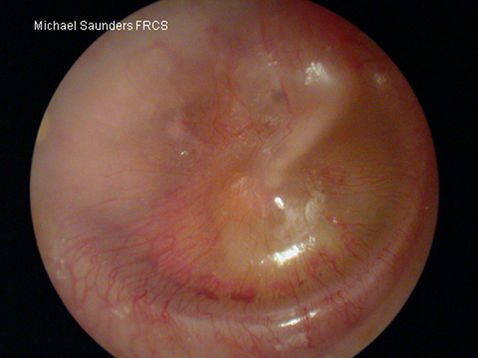Glue Ear: Guide
|
|
Hearing LossGlue Ear adversely impacts the movement of the eardrum and the ossicles reducing how effectively sound is conducted to the inner ear. Fluid in the ear can result in decreased hearing.
This picture of the eardrum shows the presence of middle ear fluid (Otitis Media with Effusion). Sound is measured in decibels (dB) with normal conversational voice around 60dB. A hearing test measures the quietest sounds that can be heard (hearing threshold) at different frequencies. The frequencies tested range from low frequencies sounds (125Hz) to high frequency sounds (8000Hz), similar to the low notes and high notes on a piano. This information is recorded on a graph called an audiogram, shown below.
The British Society of Audiology (2018: 27) uses four audiometric descriptors to categorise the degree of hearing loss. Descriptor Average hearing threshold levels (dBHL) Mild hearing loss 21 - 40 Moderate hearing loss 41- 70 Severe hearing loss 71-95 Profound hearing loss In excess of 95
Glue Ear can result in a mild to moderate conductive hearing loss. Speech will sound quieter and muffled. A child with Glue Ear will be able to hear many sounds around them, so it may not be obvious that they have a hearing loss. An audiogram of familiar sounds shows that many sounds in the environment are louder than 50dB. However on this chart the sounds of speech are all below this level, with the exception of more powerful vowel sounds. Some speech sounds such as 'f', 's' and they are very quiet (20dB) high frequency sounds and are unlikely to be heard clearly (if at all) by a child with a conductive hearing loss. Glue Ear usually causes a mild hearing loss of between 20-40dB. Each year 840 babies are born with a bilateral sensorineural hearing loss (Watkin 2001). A child with a permanent sensorineural hearing loss can also have Glue Ear, resulting in a conductive overlay or mixed hearing loss. Further information about the types of hearing loss is available on the NDCS website and in the booklet, ‘Understanding your child’s hearing tests’. An additional conductive component for a child with a mild sensorineural hearing loss who was previously unaided, may mean that they are no longer able to access speech clearly enough to make sense of the spoken word. A child with a moderate or severe hearing loss will need to have their hearing aids reprogrammed to ensure appropriate amplification. The fluctuating nature of an additional conductive component can be difficult to manage. Parents become skilled at knowing how their child responds to speech. If you are concerned that a young child with a hearing loss is responding differently, trust your instincts and contact your hearing assessment centre for your child to have a hearing test. Whitton and Polley (2011) concluded that a degraded signal in critical periods of early development can result in deficits in perception, brain physiology and an immature auditory system. The NDCS has made a video for teachers to explain the impact that a mild hearing loss can have on a child’s education. It states that a child with a mild hearing loss can miss up to 50% of what is said in classroom and outlines 5 top tips to help. This information is also included in a booklet for teachers entitled, 'At least one child in your class could have a mild hearing loss.' References: Advanced Bionics (2015) Tools for Schools, Audiogram of familiar sounds [Online] Available at: https://advancedbionics.com/us/en/home/support/tools-for-schools.html [Accessed: 9 Sept. 2023]. NDCS (2019) Understanding your child’s hearing tests [Online] Available at http://www.ndcs.org.uk/family_support/childhood_deafness/understanding_childhood_deafness/ [Accessed: 9 Sept. 2023]. Watkin P (2001)in Ballantyne’s Deafness, 6th edition. Whurr: London Whitton, J. and Polley, D. (2011) ‘Evaluating the Perceptual and Pathophysiological consequences of auditory deprivation in early postnatal life: A comparison of Basic clinical studies.’ Journal of the Association for Research in Otolaryngology 12: pp. 535- 546. |





